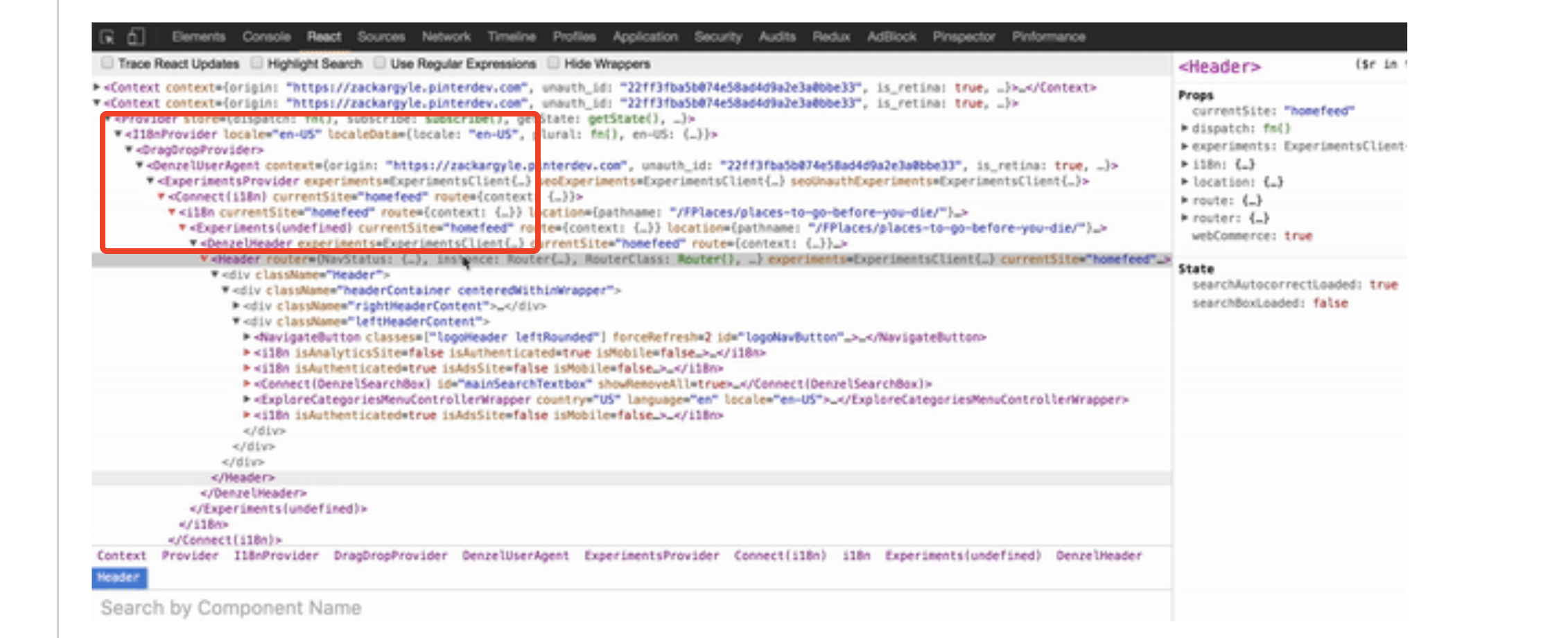前言
这篇文章主要讲Hooks,如果你想了解React 16的其他新特性,请移步 React 16新特性全解 (上), React 16新特性全解 (中)
v16.8 Hooks
Hooks是什么?
我们知道,functional component在使用的时候有一些限制,比如需要生命周期、state的时候就不能用functional component。 而有了Hooks,你就可以在funtional component里,使用class component的功能:props,state,context,refs,和生命周期函数等等。
虽然Hooks已经有要取代正宫class的趋势了,但是react目前没有计划抛弃class,所以不要慌,你还是可以跟往常一样使用class。
在真正介绍Hook之前,还是一样先来了解为什么要引入Hooks?其实不单单是为了给functional component赋于class component的功能。
还有下面的问题:
1.组件之间很难复用逻辑
之前如果我们需要复用逻辑,常用的两种方式是render props 跟 higher-order components。但是这两种方式都需要你重构代码,所以比较麻烦。
最重要的是,用这两种方式的话,在React Devtools里,会看到很多的嵌套组件。

在这个图可以看到Header外层套着很多嵌套组件。
2.复杂组件很难理解
在之前的class component里,我们的生命周期函数里通常放着不相关的代码,而相关的代码确要放在不同的生命周期函数里。这样说可能有点绕,我们来看一个具体的例子。
class App extends React.component {
componentDidMount() {
window.addEventListener('scroll', () => {console.log('a')})
this.fetchData();
}
componentDidUpdate() {
this.fetchData();
}
componentWillUnmount() {
window.removeEventListener('scroll', () => {console.log('a')})
}
render() {
return <div>ddd</div>
}
}
这应该是我们平时会经常写的代码。在componentDidMount里做事件绑定,获取数据。在componentWillUnMount里解绑事件。
这样做的问题是:componentDidMount装着的代码都是不相关的,而相关联的事件绑定以及事件解绑,分散在componentDidMount 跟 componentWillUnMount里。这样如果组件的逻辑越写越复杂之后,就会变得很难维护易出bug。
后面讲Effect Hook的时候,我会介绍这个问题用Hooks怎么解决。
3.class比较难学
React团队发现class是初学者学习React的大障碍。要学习class component,你必须要知道几点:
- this在JS是如何工作的(光是这个就够绕的)
- 记得绑定事件
- 了解state,props,state以及从上而下的数据流
- functional component跟class component的区别,如何使用它们
如何使用
理解了Hooks诞生的原因,接着来看看要如何使用。
假设我需要实现一个功能,点击app时候,count数目加一。用class的形式实现就是 这样的:
Class:
class Example extends React.Component {
constructor(props) {
super(props);
this.state = {
count: 0
};
}
render() {
return (
<div>
<p>You clicked {this.state.count} times</p>
<button onClick={() => this.setState({ count: this.state.count + 1 })}>
Click me
</button>
</div>
);
}
}
Hooks:
如果需要用Hooks实现,变成
import React, { useState } from 'react';
function Example() {
// Declare a new state variable, which we'll call "count"
const [count, setCount] = useState(0);
return (
<div>
<p>You clicked {count} times</p>
<button onClick={() => setCount(count + 1)}>
Click me
</button>
</div>
);
}
在这里demo中。useState就是Hook。我们通过它来在function component里加入state数据。
两者对比如下:
1. 定义state变量
Class:
class Example extends React.Component {
constructor(props) {
super(props);
this.state = {
count: 0
};
}
Hooks:
import React, { useState } from 'react';
function Example() {
// 通过useState这个Hooks定义state变量:count。并且通过useState给count赋初始值0,只在初始化时候使用一次
const [count, setCount] = useState(0);
在function component里,我们是没有this的。所以没办法向Class那样用this来创建state,这时候Hooks闪亮登场。 通过useState这个hooks我们可以定义count这个state变量。 由Hooks定义的state变量不一定要是object,可以是string、number。传入的内容相当于给变量赋初始值。
function ExampleWithManyStates() {
// Declare multiple state variables!
const [age, setAge] = useState(42);
const [fruit, setFruit] = useState('banana');
const [todos, setTodos] = useState([{ text: 'Learn Hooks' }]);
// ...
}
2. 渲染state
Class:
<p>You clicked {this.state.count} times</p>
Hooks:
<p>You clicked {count} times</p>
可以不需要用this,直接使用count
3.更新state
Class:
<button onClick={() => this.setState({ count: this.state.count + 1 })}>
Click me
</button>
Hooks:
<button onClick={() => setCount(count + 1)}>
Click me
</button>
我们可以看到 const [count, setCount] = useState(0);useState返回两个参数,一个是当前state的值,还有一个其实是一个函数,用来改变state的值,就是setCount。
类似setState,但是不同的是,它不会将旧的state跟新的state合并在一起,而是覆盖式的重写state的值。
说完了functional component里面如何使用state之后,我们再来看如何用Effect Hook来取代生命周期。
一般我们都会在生命周期componentDidMount, componentDidUpdate与 componentWillUnmount中做一些副作用的操作,例如:获取数据,订阅,手动改变DOM。而在hooks里,这些生命周期函数都被统一成一个方法 useEffect。
下面我们来举个例子:
import React, { useState, useEffect } from 'react';
function Example() {
const [count, setCount] = useState(0);
// Similar to componentDidMount and componentDidUpdate:
useEffect(() => {
// Update the document title using the browser API
document.title = `You clicked ${count} times`;
});
return (
<div>
<p>You clicked {count} times</p>
<button onClick={() => setCount(count + 1)}>
Click me
</button>
</div>
);
}
在这个例子中,我们在useEffect 里完成了副作用的操作。demo演示
Effects Hooks 就在functional component里, 所以它可以直接访问props跟state。 React在每次render之后都会调用effect,包括第一次render。
但是这里还遗留两个问题
1、我们在开篇说到,class component有个问题就是生命周期函数里的代码都是不相关的,而相关的代码确要被打散在不同的生命周期函数里。这个问题用Hooks的话就可以解决。比如绑定、解绑事件,在使用class的时候,在componentDidMount里 监听了一个事件,之后需要在componentWillMount里给它解绑。
用Hook只需要在useEffect一个函数就可以做到。它可以通过返回一个函数来专门做清除的工作,代码如下:
import React, { useState, useEffect } from 'react';
function FriendStatus(props) {
const [isOnline, setIsOnline] = useState(null);
function handleStatusChange(status) {
setIsOnline(status.isOnline);
}
useEffect(() => {
ChatAPI.subscribeToFriendStatus(props.friend.id, handleStatusChange);
// 在这里返回一个函数来做这件事
return () => {
ChatAPI.unsubscribeFromFriendStatus(props.friend.id, handleStatusChange);
};
});
if (isOnline === null) {
return 'Loading...';
}
return isOnline ? 'Online' : 'Offline';
}
在这个case中,unsubscribeFromFriendStatus不仅仅会在组件unmount的时候 调用,同时在重新渲染的时候也会调用。
如果你只想useEffect只在mount与unmount时候调用,需要这样传一个[] 作为第二个参数。
useEffect(() => {
ChatAPI.subscribeToFriendStatus(props.friend.id, handleStatusChange);
return () => {
ChatAPI.unsubscribeFromFriendStatus(props.friend.id, handleStatusChange);
};
}, []);
2、有时候我们并不想每次state的改变,都去调用useEffect。 在class里,会这样做
componentDidUpdate(prevProps, prevState) {
if (prevState.count !== this.state.count) {
document.title = `You clicked ${this.state.count} times`;
}
}
在Hooks,可以通过给useEffect传入第二个参数,即它关注的state变量,来做到这件事。
例如:当count改变时候,才去调用useEffect。
useEffect(() => {
document.title = `You clicked ${count} times`;
}, [count]); // Only re-run the effect if count changes
注意事项:
- Hooks只可以在顶层使用。也就是说它不能写在循环体,条件渲染,或者嵌套function里
- 只可以在React的function组件里使用Hooks。
说了那么多,总结以下,其实Hooks就是帮助我们在function component里直接使用原来class component才有的特性。
以上,我们只接触到了两种hooks,还有更多比如useContext, useReducer, useCallback,感兴趣的同学可以自己看下~
最后是使用Hooks的一些建议:
一些建议
- 是否需要用hoooks重构以前的代码?
No,react团队不推荐用hooks重新写一遍。 推荐做法是新的组件可以直接使用,然后需要改老组件代码的时候在顺便改就行了。s
- 同时建议使用
Hooks可以让你使用在不需要写class的情况,只用
- 支持Hooks的工具
React DevTools对hooks已经支持。同时强烈推荐安装hooks的eslint校验库 eslint-plugin-react-hooks 。
Reac团队下一步计划
因为现在React Hooks还不能完全cover所有class的功能,虽然他们已经很相近了。目前为止Hooks不支持两个不常使用的API getSnapshotBeforeUpdate 跟 componentDidCatch,但是React团队正在努力,未来会支持的。